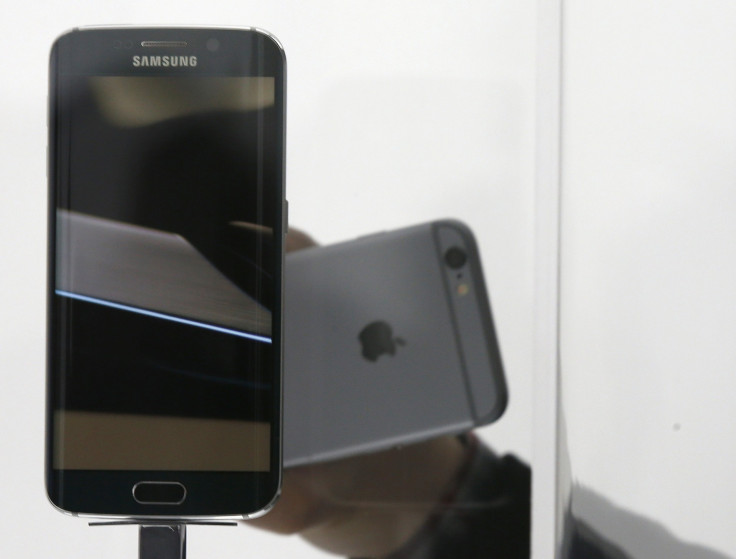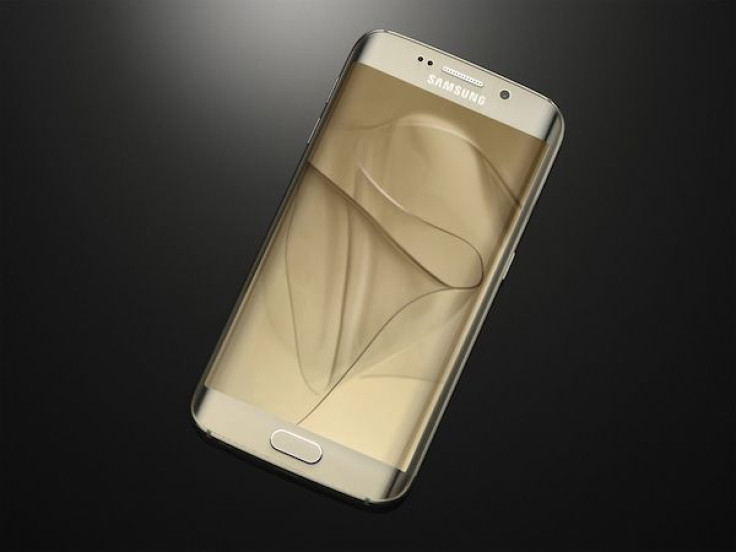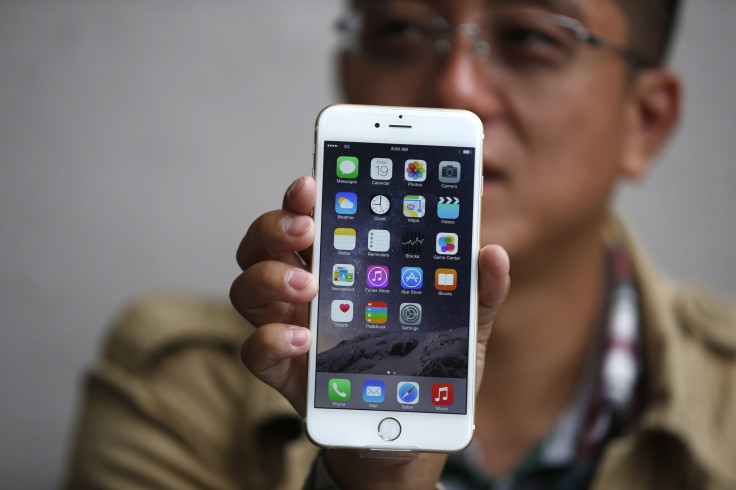Galaxy S6 Edge vs. iPhone 6 Plus: Samsung's Curviest And Apple's Biggest Go Toe-To-Toe On The Market

Both Samsung Electronics Co. and Apple Inc. have taken the smartphone market by storm -- each with not just one device, but two.
Apple released the iPhone 6 and the iPhone 6 Plus in September. Both devices feature the largest screens ever on Apple smartphones, but the iPhone 6 Plus is Apple’s first phablet: A cross between a tablet and a smartphone. Its extra large display lured away many phablet fans that only stuck with their Samsung or other Android smartphones because those were the only phablet options.
Samsung released the Galaxy S6 and the Galaxy S6 Edge last Friday. Both devices include some of the most advanced hardware, software and services specifications ever featured on a Samsung smartphone, but the Galaxy S6 Edge is currently the only smartphone on the market to feature a dual-curved display. It has the potential to attract consumers who want to play with the latest technology available.
Recent reports have compared the Galaxy S6 Edge to the iPhone 6 Plus, noting while the Galaxy S6 Edge is more expensive for Samsung to make, the iPhone 6 Plus is more expensive for consumers to purchase. But will price matter to consumers when both devices are extremely expensive?
If you can’t decide between the Galaxy S6 Edge and the iPhone 6 Plus, take a look at our comparison to help you make a choice.
Display
Samsung Galaxy S6 Edge
The Samsung Galaxy S6 Edge features a 5.1-inch Quad HD (1440x2560) resolution display with a standout feature, a dual-edge display that wraps around each side of the device. Samsung uses the Gorilla Glass 4 panel by Corning to cover its super high-resolution display. Gorilla Glass 4 is supposed to be twice as strong as the Gorilla Glass 3 panels used on most other smartphones on the market today. However, drop tests have shown the curved edges of the S6 Edge are prone to shattering if the device is dropped at an angle.
iPhone 6 Plus
The iPhone 6 Plus features a 5.5-inch Retina HD (1920x1080) resolution display. Due to its screen size, the iPhone 6 Plus is currently Apple’s first and only phablet. While phablets are growing in popularity, they remain an acquired taste. Some may find a large device like the iPhone 6 Plus difficult to hold or handle; however, software features like Reachability allow users to move and adjust the placement of applications and browsers on their screens to make the 6 Plus easier to use with one hand.
Processor
Samsung Galaxy S6 Edge
Samsung has taken a cue from Apple by using its own octa-core Exynos 7420 chip in all models of the Samsung Galaxy S6 Edge (and Galaxy S6). In the past, Samsung has collaborated with Qualcomm to provide the majority of applications processors for most of its devices. But with the Exynos 7420 chip, Samsung stands to save money by not having to pay an outside supplier for its components. It also has the opportunity to differentiate itself from the other Android smartphone-makers that use Qualcomm chips for their devices.
Samsung claims the Exynos 7420 is 30 percent to 35 percent more power-efficient than other chips now standard on the market. The Exynos 7420 is also optimized to make the battery in the Galaxy S6 Edge last longer and charge faster.
iPhone 6 Plus
The iPhone 6 Plus features Apple’s dual-core A8 processor. Apple claims its chip is 25 percent faster and 50 percent more power efficient than its previous A7 chip, found in older products like the iPhone 5s and iPad Air.
Design
Samsung Galaxy S6 Edge

The Galaxy S6 Edge is outfitted with a metal and glass exterior, which is a new feature for Samsung and has been well-received. Consumers have already applauded Samsung for the design of the Galaxy Note 4 smartphone and its A series devices. The Galaxy S6 Edge is one of Samsung’s first devices (along with the Galaxy S6) to completely do away with Samsung’s traditional polycarbonate plastic casings and feature an almost completely glass casing with metal trim.
Samsung says the metal on the Galaxy S6 Edge is 50 percent stronger than the metal on other high-end smartphones, noting it won’t bend under pressure. However, pundits such as SquareTrade Labs have tested the Galaxy S6 Edge for bendability and discovered the device bends under 110 pounds of pressure, the same force that can bend an iPhone 6 Plus. However, no Galaxy S6 Edge owners have reported having their handsets bend with everyday use.
The Galaxy S6 Edge comes in white, black and gold in the U.S., with a green color option also available globally.
iPhone 6 Plus

Apple introduced a completely new design with the iPhone 6 Plus (and iPhone 6). In addition to making the device bigger, it favored a design with more rounded corners over the boxy designs of older iPhones. Instead of a glass back panel, Apple made the iPhone almost entirely out of metal, giving the material a matte finish.
The iPhone 6 Plus is infamous for the “bendgate” fiasco that occurred on its release in September. Some users found the device would bend if they placed it in a back pocket and sat down. However, there haven’t been any bendgate complaints since the initial reports.
The iPhone 6 Plus comes in white, gold and space gray (black) color options.
Battery
Samsung Galaxy S6 Edge
The Samsung Galaxy S6 Edge includes a 2,600 mAh non-removable battery, which Samsung claims allows for as much as 26 hours of talk time on a 3G network, 13 hours of video play, 58 hours of music play and 10 hours of 3G Internet use, 12 hours of LTE Internet use and 13 hours of Wi-Fi Internet use.
The Galaxy S6 Edge also includes a fast-charging technology that allows the device to gain four hours of battery life with a 10-minute charge. The device can also charge from 0-to-100 in half the time of an iPhone 6, Samsung claims.
The Galaxy S6 Edge also includes built-in wireless charging technology, meaning there is no need for extra accessories to enable wireless charging, like special cases. The technology is compatible with the two top wireless charging standards -- Wireless Power Consortium and Power Matters Alliance -- so users will be able to charge their devices wherever a charging pad is available, such as cafes, restaurants and offices. The Galaxy S6 Edge also charges via a USB 2.0 adapter.
iPhone 6 Plus
The iPhone 6 Plus includes a 2,915 mAh non-removable battery, which Apple claims allows for as much as 24 hours of talk time on a 3G network, 14 hours of video play, 80 hours of music play and 12 hours of 3G Internet use, 12 hours of LTE Internet use and 12 hours of Wi-Fi Internet use.
The iPhone 6 Plus is charged via a USB 2.0 enabled lightning charger.
Camera
Samsung Galaxy S6 Edge
The Samsung Galaxy S6 Edge features a 16-megapixel rear camera with optical image stabilization and a 5-megapixel front camera. The rear camera includes an f/1.9 aperture lens, which lets in more light than the lenses on older Galaxy models, allowing for sharper photos. Real-time HDR and low-light shot features also enhance picture taking. Samsung claims Galaxy S6 Edge is superior at taking low-light photos than the iPhone 6 Plus.
iPhone 6 Plus
The iPhone 6 Plus features an 8-megapixel rear camera with optical image stabilization and 1.2-megapixel front camera. The camera includes an f/2.2 aperture lens, which is a camera standard. The iPhone 6 Plus includes optical image stabilization, which helps users take images with less blur, while the iPhone 6 does not. Apple included features such as slow motion and time lapse on the iPhone 6 Plus camera app.
Software
Samsung Galaxy S6 Edge
The Samsung Galaxy S6 Edge features the Android 5.0 Lollipop operating system by Google. The latest version includes features such as the Material Design interface, which makes the system simpler and easier to navigate.
Samsung has also cleaned up its own TouchWiz user interface, which features simple colors that are associated with different applications. Pages for the phone app are highlighted in green, pages for the video app are highlighted in purple and pages for the contacts app are highlighted in orange. Additionally, Samsung has switched from icons to text for better recognition on many applications.
Improving on its security software, Samsung has partnered with BlackBerry to integrate Samsung’s Knox software with BlackBerry’s WorkLife and SecuSUITE.
iPhone 6 Plus
The iPhone 6 Plus features the iOS 8 operating system, which has features including third-party keyboards, interactive notifications, Touch ID development, and updates to spotlight, mail, messages and other applications.
Memory and Storage
Samsung Galaxy S6 Edge
The Samsung Galaxy S6 Edge includes 3GB of RAM and 32GB, 64GB and 128GB internal storage options. Like many Android smartphone-makers, Samsung put large amounts of RAM in its devices. Higher RAM, or random access memory capacities often help smartphones run faster.
Samsung has also increased the amount of long-tem internal storage in the Galaxy S6 Edge after deciding not to give the smartphone a removable back like older Galaxy devices. Now users can’t expand storage capacity on their own, but they do get more memory out of the box.
The 32GB Galaxy S6 Edge has about 23GB of storage available the users, with 9GB of the total storage going to the operating system and preinstalled software. But many of Samsung’s older smartphones start at 16GB of internal storage, and users only had about half of the device’s total storage available for personal use.
The 32GB option is viable for many users, but those who are unsure might want to consider the 64GB option.
iPhone 6 Plus
The iPhone 6 Plus includes 1GB of RAM and 16GB, 64GB and 128GB internal storage options. Many complain Apple has not increased its RAM capaciy in several devices, but the smartphone-maker says the iPhone 6 Plus is optimized so it doesn’t need as much RAM.
The iPhone 6 Plus starts at 16GB of internal storage, but its next tier offers three times the space for $100 more. The iOS 8 operating system takes up about 3GB total memory, leaving users with about 13GB for their own use. This is a decent capacity, but it can fill up easily with photos and music. For this reason, the 64GB option may be the most viable option for most users.
Network/Connectivity
Samsung Galaxy S6 Edge
The Samsung Galaxy S6 Edge is compatible with 2G, 3G and 4G LTE networks and is powered by a single network SIM card.
Its connectivity features include the latest Wi-Fi and Bluetooth standards, USB 2.0, GPS and Glonass location technology and a 3.5mm Stereo jack.
iPhone 6 Plus
The iPhone 6 Plus is compatible with 2G, 3G and 4G LTE networks and is powered by a single network SIM card.
Its connectivity features include the latest Wi-Fi and Bluetooth standards, USB 2.0, GPS, Glonass and iBeacon location technology and a 3.5mm Stereo jack.
Sensors
Samsung Galaxy S6 Edge
Sensors on the Samsung Galaxy S6 Edge include an Accelerometer, Barometer, Gyro Sensor, Geomagnetic Sensor, Hall Sensor, HR Sensor, Light Sensor and Proximity Sensor.
The Galaxy S6 Edge also includes an updated Finger Scanner sensor, which works more like the Touch ID fingerprint sensor on the iPhone. Samsung’s old sensor used a swipe motion on the home button on a compatible smartphone to activate the fingerprint sensor.
The new sensor on the Galaxy S6 Edge works when users touch their fingers to the home button at any angle. This allows for easier activation of features and services connected to the fingerprint sensor.
iPhone 6 Plus
Sensors on the iPhone 6 Plus include a Barometer, Three-axis gyro, Accelerometer, Proximity sensor, Ambient light sensor and the Touch ID fingerprint sensor.
Services
Samsung Galaxy S6 Edge
The Samsung Galaxy S6 Edge includes the Samsung Pay system. The system, developed by Samsung’s new subsidiary Loop Pay, is compatible with the magnetic strips on credit cards as well as with near-field communication payment systems (NFC), making it automatically accepted at most retailers.
Samsung updated its fingerprint sensor from a swipe-based sensor to a touch-based sensor, like Apple’s Touch ID, mostly to simplfy the process of authenticating Samsung Pay with a fingerprint.
iPhone 6 Plus
The iPhone 6 Plus includes the Apple Pay system. The system uses NFC technology, which allows an iPhone 6 Plus handset to communicate with NFC hardware in stores to enable a transaction.
Apple Pay is accepted only at retailers that have compatible NFC hardware, which is about 10 percent of all retailers. But Apple is constantly adding new Apple Pay partners.
Price and Availability
Samsung Galaxy S6 Edge
The Samsung Galaxy S6 Edge is available at carriers including Verizon, AT&T and Sprint starting at $299.99 with a two-year contract and at T-Mobile starting at $0 down and $32.49 per month for 24 months. The smartphone will also be available at carriers and retailers including Boost Mobile, Cricket Wireless, MetroPCS, Amazon, Costco, Sam’s Club, Target and Walmart.
The Galaxy S6 Edge starts at about $699 unlocked, depending on the carrier or retailer.
iPhone 6 Plus
The iPhone 6 Plus is available at carriers including Verizon, AT&T and Sprint starting at $299.99 with a two-year contract and at T-Mobile starting at $0 down and $31.34 per month for 24 months. The smartphone is also available directly through Apple in stores as well as online.
The iPhone 6 Plus starts at about $749 unlocked, depending on the carrier or retailer.
© Copyright IBTimes 2024. All rights reserved.












